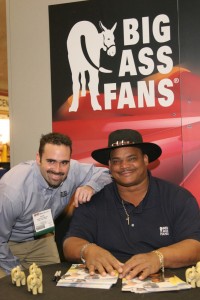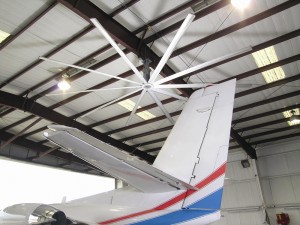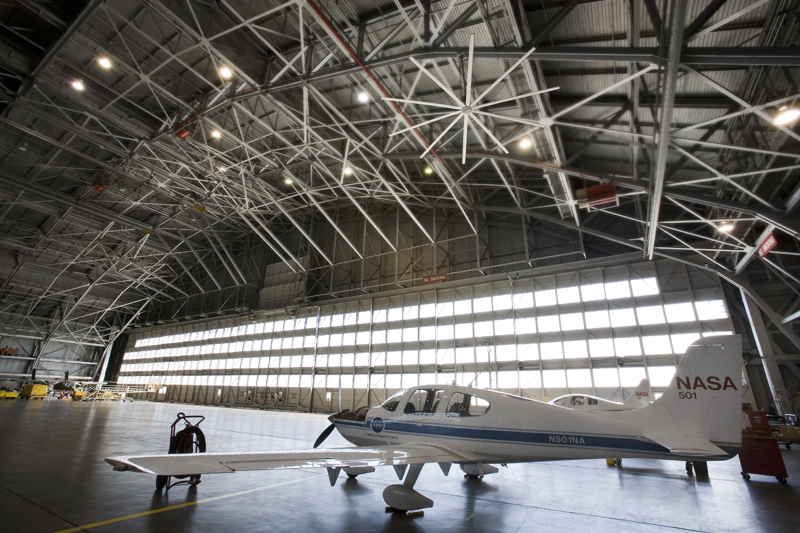
NASA’s Langley Research Center in Hampton, Va., bought fans primarily for summer cooling but found them useful for moving heated air from the high ceilings to floor level during winter months.
By Clayton Moore
Anybody who runs an aviation hangar or large manufacturing space—especially those that aren’t air-conditioned—knows that summertime can be a miserable experience. A Kentucky-based company with a funny name has a terrific product to solve the problem.
The Big Ass Fans Company was founded in 1999 as the HVLS (High Volume/Low Speed) Fan Company, a name that nodded to its innovative technology. Founded by entrepreneur James Carey Smith, the company dedicated itself to finding better technologies to cool and maintain air flow in large facilities. Its answer was to manufacture large-diameter fans that generate air movement over large areas, relieving much of the suffocating heat and stagnant air in such spaces.
But no one was calling Smith’s company the HVLS Fan Company. Faced with fans that reach 24 feet in diameter, customers had a more frank observation.
“By about 2000, we were noticing that all of our customers were referring to us as ‘the company that makes those big-ass fans,'” said Heather Henley, who manages the delicate task of public relations for the company. “So we embraced the name and went with that identity.”

John Plumley, an engineering sales representative (left), shows off logo merchandise with the help of William “The Refrigerator” Perry.
Since then, the controversial name has become as much a part of the company’s character as its enormous energy-efficient fans. But for customers like Lockheed Martin and NASA, the product’s name is a minor consideration next to the enormous value the fans bring.
The staff at the Lockheed Martin Aircraft & Logistic Center in Greenville, S.C., recently learned just how cool the fans can be. The facility, which performs maintenance and repair operations on military aircraft, was suffering unbearable heat in its shipping and receiving warehouse. After installing just one of the company’s fans, employees saw immediate results.
“Big Ass Fans was the first application I’d seen of a low-velocity air movement device,” the lead facility engineer told a fan company representative. “Most devices in use were smaller, high-velocity fans that generated a lot of noise, which in our case would’ve been distracting and annoying to the workforce. Our Big Ass Fan is a great way to move air in our warehouse facility, and it provides a better work environment for our workforce.”
Technically, the fans don’t make the temperature cooler. But while the scientific principle might seem unsound, it’s hard to dispute the results of the fan’s considerable air movement.
“It’s called ‘lowering the effective temperature of the area,'” Henley said. “You don’t actually lower the temperature of the area by evaporative cooling, as you would with air conditioning. The breeze that the fans generate make sweat evaporate off your skin, so you feel cooler faster. It can actually make you feel 11 to 17 degrees cooler than you would without our fans.”
In fact, a great deal of scientific research has gone into their design, led by Dr. Richard Aynsley, the company’s director of research and development.
“We might have a silly-sounding name, but there’s a lot of science behind the fans,” Henley said. “We have a whole research and development department that has poured a lot of effort into these products. We’re not just making a big fan. We’re making specially engineered fans for very specific spaces.”

Alcoa Fujikura, in San Antonio, Texas, utilizes a 24-foot Big Ass ceiling fan to cool a 100,000-square-foot hangar and stop condensation from forming on its corporate jet.
The company has put more than 20,000 fans into operation since it was founded. Among the many locations for the fans are dairy farms, restaurants, manufacturing facilities, arenas and other large-scale spaces that are difficult to heat and cool. The fans are sold in two-foot increments and cost approximately $4,000 to $6,000, depending on their size.
“When you consider that you can cool your entire space with one or two of our fans, versus a host of column fans, it’s a pretty good value,” Henley observed.
Each fan is outfitted with multiple safety features and is extremely energy-efficient. On a slower winter setting, the fans push warm air down from the ceiling and use less energy than a 60-watt light bulb, according to Henley.
Aviation has been an increasing market, and the company has placed fans in hangars from coast to coast.
“Big Ass Fans are in corporate hangars all over the country,” Henley said. “We’re trying to get into more private hangars, because it’s the perfect application for this technology. Aircraft hangars are particularly well-suited, because they’re large and expensive to cool, and the doors are opening and closing all the time.” Our fans will accommodate that function but still provide a significant cooling apparatus for those spaces.”
The products are also gaining attention with those who design fixed base operations and hangars.
“Architects and engineers are very excited about our products,” Henley said. “They’re intrigued, because not only do the fans work, but they also look cool. A lot people in private aviation are interested in making their hangars and facilities into real show pieces. Our fans can definitely contribute to that aesthetic.”
Big Ass Fans’ manufacturing center employs nearly 100 workers at its headquarters in Lexington, Ky. The site is outfitted with pool and ping-pong tables, as well as an assortment of working Big Ass Fans to cool its own workers. It’s easy to recognize the building; it’s the one with the big donkey on it.
To capitalize on its funny name, the company created a Big Ass Fans logo, complete with the aforementioned animal. Its branded merchandise quickly became a hot seller, and the company donates all profits from merchandise sales to the Longhopes Donkey Shelter, a nonprofit donkey rescue shelter in Bennett, Colo.
When looking for a spokesman, the company decided former National Football League star William “The Refrigerator” Perry was perfect.
“We were looking for somebody that our customers would enjoy,” Henley said. “He’s a big guy, and we make big fans. It’s a great fit. He just delivered a fan to a customer in Sikeston, Mo. He’s been a great partner with us and he’s very accommodating.”
The city of Lexington has been a little more cautious in embracing the company, which has endured its share of protests against its contentious name. But Big Ass Fans seems to have won over many of its neighbors.
“The community has come around,” Henley said. “We’ve actually won some ‘manufacturer of the year’ awards for our state and region. People are starting to see that we’re here, and we’re serious about what we do.”
The company is very serious about its delivery time. Its production line is extremely efficient. Once a customer orders a fan, it’s shipped and on its way within 24 hours.
“If you order a fan from us, you’ll be a hero to your employees by the end of the week,” Henley said.
For more information about Big Ass Fans, visit [http://www.bigassfans.com].












